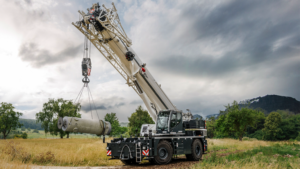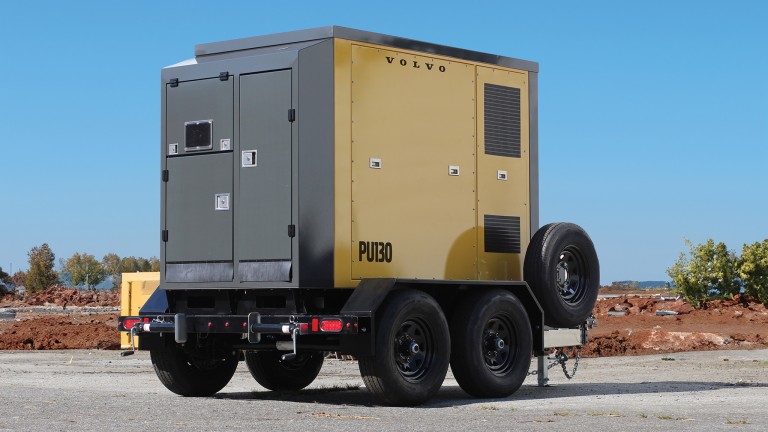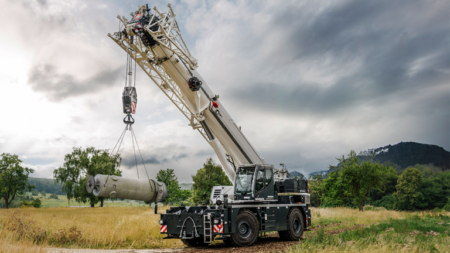The PU130 is easier to operate than a standard diesel generator.
Portable Electric
Portable Electric partners with Volvo CE
There is no industry standard for construction EV charging. “Currently there are two different voltage architectures used in the construction EV space — less than 96 volts or low voltage; and greater than 96 volts, usually around 400 volts, or high voltage,” says Marett. “Each of these solutions requires their own matching fast charging solution and in the case of Volvo, which utilizes a 48-volt architecture for their compact equipment, we had to design a specific low-voltage charging solution.”
Volvo isn’t the only OEM that Portable Electric has developed a charging solution with — the company worked with LeeBoy. Leeboy, however, leverages automotive high-voltage architectures and requires a high-voltage charger which wouldn’t be compatible with the Volvo machines. However, Portable Electric’s experience working with Leeboy has helped inform its work with Volvo. The Voltstack 30k that was paired with LeeBoy’s 8520C E-Paver demonstrated that it could quickly charge the machine and keep it working. Portable Electric started work with Volvo exploring Level 2 charging options, which operate on currents of 12 to 80 amperes.
“The challenge we found was it was just taking too long on Level 2 — anywhere from six to eight hours to recharge that equipment,” Marett says.
“We call it low-voltage DC fast charging — it’s similar to what you’d find in a Tesla supercharger, but it’s done at low voltage capacity for construction equipment. That cuts the charge time down from what we were doing at Level 2, six to eight hours, down to a half-hour or less,” Marett describes.
A robust charging solution designed for harsh job site conditions
Designed to power both electric construction machines and job site tools and structures, the PU130 has a storage capacity of 130 kWh and a low-voltage DC fast charging rate of 20 kW, combined with a 40 kW AC output. It uses LFP — lithium iron phosphate — batteries and this rugged unit can be towed across rough roads or into dusty, dirty environments and still operate smoothly. It also has a broad operating temperature range, including sub-zero.
“If you’re just doing straight equipment recharging, you can typically get six to eight pieces of equipment recharged off that. If you’re adding other loads, such as tools or lighting, that’s going to vary the capability,” Marett says.
Once the PU130 needs to be recharged, it can be trickle charged from low-amperage site power connections, swapped for another unit and recharged off-site, or paired with a traditional generator. During downtime, the generator runs long enough to quick-charge the battery unit, then shuts back down. The generator runs far less and produces less emissions when charging the battery than it would need to if charging machines directly. Typically it will take four to six hours to recharge the PU130 off the grid.
The PU130 is simple to use compared to generators — in fact, it’s a one-touch system, Marett says. Portable Electric’s PowerAi intelligent controller is built into each unit and manages the flow of power, automatically switching between AC and DC or running both simultaneously, depending on the needs of the user and application. PowerAi communicates with Portable Electric’s Neuron OS software which allows for remote monitoring and provides real-time data, analytics, and GPS tracking for the unit.
“If you’re a fleet manager you can see all the units deployed, the state of charge, the data from the field, and how often they’re being used,” Marett says. “Because these systems are reducing CO2, we can do carbon capture or carbon offset calculations, which is a huge benefit.”
The PU130 eliminates the need for generators to idle throughout the day, and, when paired with zero-emission electric construction equipment, significantly reduces emissions on the job.
“From the pure CO2 and emissions standpoint, there is a lot of benefit to the electrified approach,” Marett says. “There’s also the silence — you can stand right next to our battery energy storage system and not even know it’s on, just like you can stand next to one of these Volvo excavators and not know it’s on. It makes job site communication way easier and way more effective.”
The PU130 provides Volvo and Portable Electric with an opportunity to demonstrate that productivity on an electrified job site is just the same as a diesel-powered site, with the added benefits of reduced fuel cost and carbon emissions.
“With the PU130, we’ve removed the productivity gap. Users should be much more willing and able to adopt electrified construction vehicles,” Marett concludes.
Read the full article here











